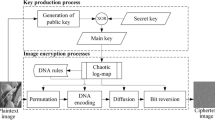Abstract
The results of the author’s collective research on the theory of associative steganography are systematized in order to bring them to a wide range of developers and users of stegosystems. The concept of associative steganography is associated with the associative protection of a finite set of object types and their coordinates, the decimal code symbols of which are represented by masked binary matrices of the same size. Consideration is carried out from positions of constructive modeling of systems. The accepted postulates on the principles of concealment, the logical interpretation of the criterion of Shannon’s perfect secrecy, the choice of the sizes of matrices and the randomizing gamma are explained. The masking algorithm is described. Estimates of the effectiveness of associative protection are given: the proof of the basic theorem, the estimation of speed, stiffness and noise immunity.
Similar content being viewed by others
References
R. O. Duda and P. E. Hart, Pattern Classification and Scene Analysis (Wiley, New York, 1973).
Steganography. http://dic.academic.ru/dic.nsf/ruwiki/30097.
V. A. Raikhlin, Constructive System Modeling (Fen, Nauka, Kazan’, 2005) [in Russian].
E. P. Nikitin, The Explanation is the Function of Science (Nauka, Moscow, 1970) [in Russian].
Yu. A. Shreider and A. A. Sharov, Systems and Models (Radio i Svyaz’, Moscow, 1982) [in Russian].
D. S. Kontorov, Attention - Systems Engineering (Radio i Svyaz’, Moscow, 1993) [in Russian].
D. Hilbert and P. Bernays, The Foundations of Mathematics (Springer, Berlin, 1934).
I. S. Vershinin, R. F. Gibadullin, S. V. Pystogov, and V. A. Raikhlin, Associative Steganography (Appendix to Scene Analysis), Ed. V. A. Raikhlin (Kazan. Univ., Kazan’, 2014) [in Russian].
C. E. Shannon, “Communication Theory of Secrecy Systems,” Bell Syst. Technol. J. 28, 656–715 (1949).
What is Mersenne Twister (MT)? www.math.sci.hiroshima-u.ac.jp/_m-mat/MT/ewhat-is-mt.html.
D. A. Ker, “A capacity result for batch steganography,” IEEE Signal Process. Lett. 14, 525–528 (2007).
GOST (State Standard) No. 28147–89, Information processing systems. Cryptographic protection. Cryptographic algorithm (1989).
R. F. Gibadullin, “Database system mapping with associative protection,” Cand. Sci. (Tech. Sci.) Dissertation (Ufa, 2011).
AES—Advanced Encryption Standard. https://ru.bmstu.wiki/AES_(Advanced_Encryption_Standard).
Author information
Authors and Affiliations
Corresponding authors
About this article
Cite this article
Raikhlin, V.A., Vershinin, I.S. & Gibadullin, R.F. The Elements of Associative Stegnanography Theory. MoscowUniv.Comput.Math.Cybern. 43, 40–46 (2019). https://doi.org/10.3103/S0278641919010072
Received:
Published:
Issue Date:
DOI: https://doi.org/10.3103/S0278641919010072




